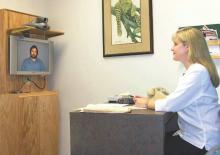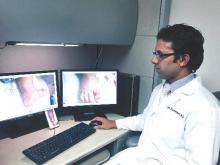By the time Dr. Karen Edison saw the 41-year-old patient, several days had passed since his wife had first noticed a discolored spot on his back. Harvest season was underway, and the North Central Missouri farmer was reluctant to leave the fields and visit a physician.
Making matters more challenging, the family lived in a rural area nearly 3 hours away from a major medical center. The patient’s wife finally convinced her husband to visit a local hospital that had a telemedicine unit. Miles away at University of Missouri Health in Columbia, Dr. Edison viewed high-quality digital photos of the man’s back and spoke to the patient via video conferencing. Dr. Edison determined the blotch was a melanoma with a 1.1-mm Breslow measurement. The patient underwent a wide local excision along with a sentinel lymph node biopsy, which turned out to be negative.
“It makes me feel grateful for the technology and how it lets us reach patients earlier and gets them diagnosed correctly,” said Dr. Edison, Philip C. Anderson Professor and chair of the dermatology department at University of Missouri Health and medical director for the Missouri Telehealth Network. “This saves patients’ suffering and can save patients’ lives. It certainly did in this case,” he said.
Similar outcomes are playing out across the country as telemedicine use continues to grow, especially among dermatologists. Analysts predict the number of health providers offering telemedicine will rise from 22% in 2014 to 37% in 2015, according to research by Towers Watson, a professional services company. Another report, BCC Research, a market research company, shows the global telehospital/clinic and telehome market is expected to reach about $43 billion in 2019, up from $19 billion in 2014.
Dermatologists fit rather smoothly into the telemedicine space, said Dr. Edison, who has used telemedicine in some form for 20 years. “Dermatology is uniquely suited for use of the technology because we are a visual specialty,” she said in an interview. “The value of our expertise is in the training we [have] to diagnose.”
Best teledermatology uses
Teledermatology is one of the most active applications of telemedicine rendered in the United States, according to the American Telemedicine Association (ATA). Common uses include “store and forward,” a technique that uses asynchronous still digital image technology for communication, and “real-time interactive,” which uses videoconferencing technology. Dermatologist Raja Sivamani of the University of California Davis Health System is taking these approaches one step further by working to integrate mobile phone photography and cloud-based communications.
“Previously, the technology had to be separated between the photography and the communication,” Dr. Sivamani said in an interview. “However, now we are seeing that this can be combined on the same platform, making the communications less cumbersome.”
Dr. Sivamani and his colleagues are currently using the technology for research studies and to set up communication channels overseas between hospital dermatologists, remote villages, and health outposts in both Nepal and Sri Lanka, he said.
Consults with other specialists also top the list of beneficial uses of teledermatology. In a survey of 2,016 doctors by American Well, a telehealth services company, physicians ranked dermatology video consults as the most valuable video consult of all the specialties. To address this need, the American Academy of Dermatology and the University of Pennsylvania jointly developed AccessDerm, a national program that provides primary care providers who work in participating clinics with free access to the expertise of dermatologists, who are AAD members. The program allows primary care clinicians to submit consultations that dermatologists receive on their personal mobile devices or the Internet via HIPAA-secure means. AccessDerm is now being used in 16 states, but the AAD is seeking to increase participation by clinics in all 50 states.
“In addition to addressing physician shortages from a clinical standpoint, teledermatology programs are very important for vulnerable citizens in the United States and abroad,” Dr. William D. James, vice chair of the department of dermatology for Penn Medicine and a past AAD president said in a statement. “It is wonderful that the impact of these teledermatology consultations continues to expand.”
An essential key to teledermatology is image quality, noted Dr. Dennis H. Oh of the University of California, San Francisco. He is assistant chief of dermatology at the San Francisco VA Medical Center and a member of the ATA’s Teledermatology Special Interest Group. At the VA Medical Center in San Francisco, photography is done by dedicated imagers trained and certified through a standardized curriculum, Dr. Oh said in an interview. The quality of images is also regularly monitored, he added.



